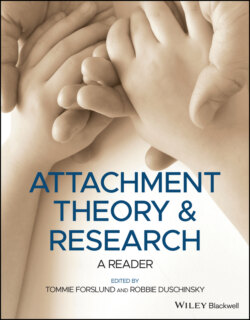Читать книгу Attachment Theory and Research - Группа авторов - Страница 18
Conclusion
ОглавлениеAlthough in the course of this paper we have strayed into areas of difficult and abstract theory, my interest in the problem stems from clinical observation. At first I was struck by the calamitous after‐effects which are sometimes to be found following a prolonged separation or series of separations occurring in early childhood. Next, in my work with James Robertson, we were both struck by the intensity and universality of separation anxiety when very young children are removed from their mothers, by the processes of grief, mourning, and defence which habitually follow if child and mother are not reunited, and by the acute exacerbation of separation anxiety after the child’s return home. Finally, like most other clinicians, I have been impressed both by the frequency with which separation anxiety is exhibited at high levels in neurotic patients and by its ubiquity at more modest levels in the everyday life of all of us. It has been the attempt to understand and explain these observations which has led to this exploration of theory.
It will have been seen that the hypothesis advanced to account for separation anxiety is an immediate corollary of that advanced to account for the child’s tie to his mother. In the earlier paper reasons were advanced why it was both legitimate and economical to conceive the child’s tie as being the direct outcome of a number of instinctual response systems – crying, smiling, sucking, clinging, and following – which have become bred into the species as a result of their survival value. When they are activated and the mother‐figure is available, attachment behaviour follows. Similarly, as we have discussed in this paper, when they are activated and the mother‐figure is temporarily not available, protest behaviour and separation anxiety follow. This formulation not only has the merit of appearing to account for the facts but is also simple. Furthermore, it brings separation anxiety into immediate relation to grief and mourning, which in this scheme are seen respectively as the subjective experience and the psychological processes which occur when the responses mediating attachment behaviour are activated and the mother‐figure is permanently unavailable, or at least believed to be so. A liability to experience separation anxiety and grief are thus the ineluctable risks of a love relationship, of caring for someone. This intrinsic connexion between separation anxiety and grief, and both with attachment to a loved object, to which Freud called attention in the final pages of Inhibitions, Symptoms and Anxiety, is also the theme of succeeding papers on grief and mourning in infancy.
